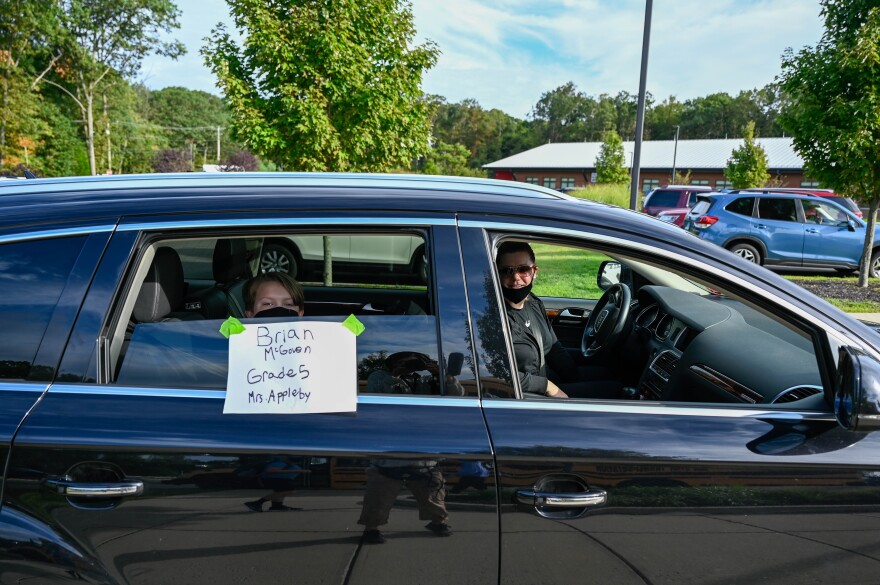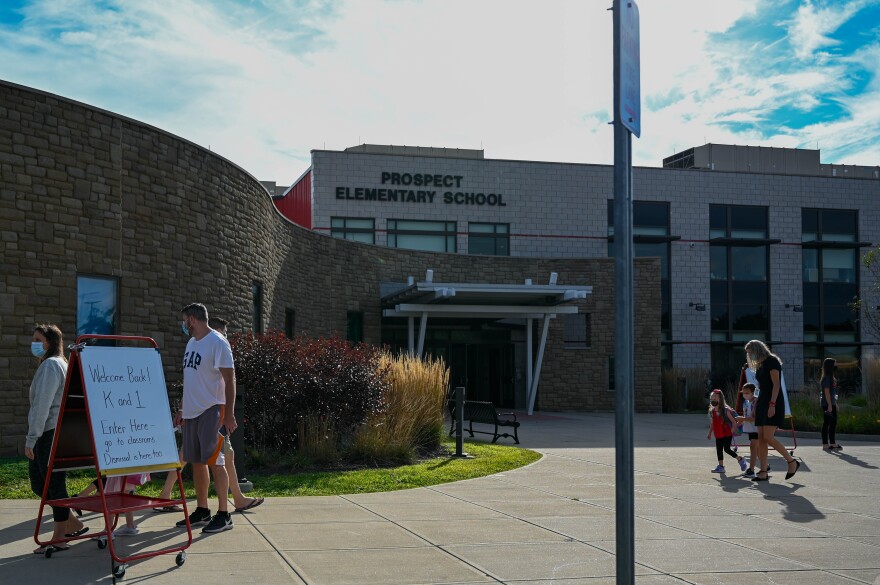Brian McGovern reached out of his window to tape a sign to the outside of his mom’s car as they pulled into the parking lot at Prospect Elementary School on Tuesday. In his best fifth grader handwriting, he wrote his name, year and classroom so he could be identified and guided to the proper entrance.
“Are we doing this right?” asked his mother, Liza McGovern.
The line at the school’s parent drop-off circle was longer than usual, and she wasn’t sure where to go because Brian usually takes the bus. But McGovern decided to drive him to school this year so he has a little more time before he needs to mask up and sit still all day. While they waited for the school day to begin, McGovern said she’d check in with Brian later about the size of his class. Because she, like everyone, is concerned about coronavirus.

“I’m curious to see how many kids are going to be physically in the classroom and how many people in his particular class have opted to distance learn,” McGovern said. “If there are a lot of kids still in his classroom, it might be something that my husband and I might want to discuss.”
Going back to distance learning would be an option for them. McGovern works at home. But Brian is an only child, and they both were glad he could return to the social setting of school.
It’s back-to-school time across the state, and what that means varies by district. Some are starting the year in a hybrid model, which means blending distance and in-person learning to lower the number of students in a classroom at once. Region 16 pulls students from Prospect and Beacon Falls into its schools, and it is starting with a hybrid approach.
Superintendent Michael Yamin was already aware of how populated his schools will be -- 10% of students will learn remotely.
And that choice, Yamin said, will cost his region.
“So those kids will log in during the day in the classroom, but then they’re also gonna need some extra help,” he said. Yamin calculated that it will cost him “eight to 10 hours per teacher, per 10 to 15 kids to teach them in after-school hours and support them.”
After some quick math in his head, Yamin laid out the final tally.
“It’s gonna cost my region, you know, probably $15,000 a month,” he said.
Students and parents at Prospect Elementary School had two options: four full days of in-person learning with half a day online, or fully remote online learning. The state mandated that choice. But Yamin doesn’t like the plan. He’d prefer one or the other. And if he had to choose one, he’d have the kids in the school.
“If the state’s saying all kids should start school and we should use the matrix on how safe it is, then that’s what we should have done,” Yamin said, referring to charts all districts made to plan for school in the event of low, moderate or high community transmission. “They should not have given people an option because of anxieties or because of nervousness.”
Region 16 is in line with other schools in this regard. The state Department of Education says that a majority of schools are returning fully in person or via a hybrid model. Most elementary school kids will be learning mostly in person, according to the state.
A Very Different Kind Of Drop-Off
Buses rolled up outside the school with as few as five children, and cars flooded the drop-off circle. But besides the masks, the scene looked normal for a first day of school. Families stood in units at first, with 6 feet between, but as students lined up, the 6 feet of distancing shrunk and parents gravitated together to discuss first-day jitters. Most were wearing masks.

Roman Wright and Whitney Stokes peered in the window of their daughter’s kindergarten classroom. For them, the whole point is to have their daughter in school.
“I don’t know how kids are supposed to socialize or have fun in there if they’re just kind of supposed to keep their distance and not interact with each other,” Wright said. “I think that’s what kindergarten was all about, but they’re gonna be missing out on a lot of that.”
And as for the option of distance learning, Stokes was not interested in setting a precedent.
“Because I don’t want her to think that that’s her normal,” she said of her daughter. “I want her to be able to socialize with kids her age, ’cause she’s around adults all the time anyways, so this will help.”
For parents like Wright and Stokes, who’ve had their kids at home the past six months, an education includes social time -- in a safe place for it, of course.
Ali Oshinskie is a corps member with Report for America, a national service program that places journalists into local newsrooms.





